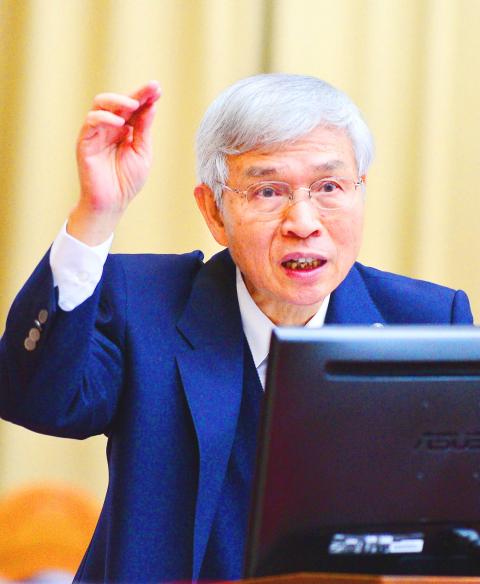Central bank Governor Yang Chin-long (楊金龍) yesterday said the bank would remove authoritarian icons from the nation’s currency if explicit orders were given by the transitional justice promotion committee to be established by the Executive Yuan.
Yang made the remark at a meeting of the Legislative Yuan’s Finance Committee, after Chinese Nationalist Party (KMT) Legislator Lai Shyh-bao (賴士葆) asked whether the passage of the Act on Promoting Transitional Justice (促進轉型正義條例) would prompt changes to the design of the nation’s currency.
Although the act was promulgated last year, the central bank cannot make changes before the transitional justice promotion committee specifies which banknotes or coins contain authoritarian imagery, Yang said.

Photo: Wang Yi-sung, Taipei Times
The act stipulates that the Cabinet is to create the nine-member transitional justice promotion committee to oversee the removal of authoritarian icons, the declassification of state archives and the rehabilitation of victims of persecution.
The committee is to be disbanded upon completing a full report on those tasks, the act says.
“Should the transitional justice promotion committee order a change to the design of the New Taiwan dollar, I believe we will have to discharge our duties according to the law,” Yang said.
Lai then asked Yang whether his comments could be interpreted as an unwillingness to follow the policy of his predecessor, former central bank governor Perng Fai-nan (彭淮南).
Lai also asked Yang whether he agrees that changing the design of the currency — which Lai said would cost NT$50 billion (US$1.7 billion) — would be a waste of taxpayer money for political purposes.
Yang responded to both questions in the negative, saying that the central bank decided during Peng’s tenure as governor that it would not change clearly apolitical and nonauthoritarian design elements of the currency.
In response to a question by Democratic Progressive Party (DPP) Legislator Liu Chien-kuo (劉建國), Yang said that the central bank does not currently have, or has ever had, a fixed limit on the upward movement of the NT dollar versus the US dollar.
Monetary policy observers have long called the exchange rate of NT$28.5 per US dollar the “Perng Fai-nan Line,” Li said, before asking Yang where he would draw the line on the NT dollar’s appreciation.
“I have followed Perng for a long time and I have never heard him say that we should hold this or that line in defense of our currency’s exchange rate,” Yang said.
The central bank would intervene and keep order if and when abnormal fluctuations occur in the market, he added.
Trying to reverse significant exchange rate fluctuations by force is counterproductive, Yang said, adding that the central bank favors a flexible approach to monetary policy.
The market yesterday appeared to respond to Lai’s comments by testing the central bank’s bottom line, with the NT dollar appreciating NT$0.057 to NT$29.200, its highest level since Jan. 31, when it reached NT$29.150.
The NT dollar yesterday opened at NT$29.245, moving between NT$29.180 and NT$29.250 before the close.

AIR SUPPORT: The Ministry of National Defense thanked the US for the delivery, adding that it was an indicator of the White House’s commitment to the Taiwan Relations Act Deputy Minister of National Defense Po Horng-huei (柏鴻輝) and Representative to the US Alexander Yui on Friday attended a delivery ceremony for the first of Taiwan’s long-awaited 66 F-16C/D Block 70 jets at a Lockheed Martin Corp factory in Greenville, South Carolina. “We are so proud to be the global home of the F-16 and to support Taiwan’s air defense capabilities,” US Representative William Timmons wrote on X, alongside a photograph of Taiwanese and US officials at the event. The F-16C/D Block 70 jets Taiwan ordered have the same capabilities as aircraft that had been upgraded to F-16Vs. The batch of Lockheed Martin

GRIDLOCK: The National Fire Agency’s Special Search and Rescue team is on standby to travel to the countries to help out with the rescue effort A powerful earthquake rocked Myanmar and neighboring Thailand yesterday, killing at least three people in Bangkok and burying dozens when a high-rise building under construction collapsed. Footage shared on social media from Myanmar’s second-largest city showed widespread destruction, raising fears that many were trapped under the rubble or killed. The magnitude 7.7 earthquake, with an epicenter near Mandalay in Myanmar, struck at midday and was followed by a strong magnitude 6.4 aftershock. The extent of death, injury and destruction — especially in Myanmar, which is embroiled in a civil war and where information is tightly controlled at the best of times —

China's military today said it began joint army, navy and rocket force exercises around Taiwan to "serve as a stern warning and powerful deterrent against Taiwanese independence," calling President William Lai (賴清德) a "parasite." The exercises come after Lai called Beijing a "foreign hostile force" last month. More than 10 Chinese military ships approached close to Taiwan's 24 nautical mile (44.4km) contiguous zone this morning and Taiwan sent its own warships to respond, two senior Taiwanese officials said. Taiwan has not yet detected any live fire by the Chinese military so far, one of the officials said. The drills took place after US Secretary

THUGGISH BEHAVIOR: Encouraging people to report independence supporters is another intimidation tactic that threatens cross-strait peace, the state department said China setting up an online system for reporting “Taiwanese independence” advocates is an “irresponsible and reprehensible” act, a US government spokesperson said on Friday. “China’s call for private individuals to report on alleged ‘persecution or suppression’ by supposed ‘Taiwan independence henchmen and accomplices’ is irresponsible and reprehensible,” an unnamed US Department of State spokesperson told the Central News Agency in an e-mail. The move is part of Beijing’s “intimidation campaign” against Taiwan and its supporters, and is “threatening free speech around the world, destabilizing the Indo-Pacific region, and deliberately eroding the cross-strait status quo,” the spokesperson said. The Chinese Communist Party’s “threats